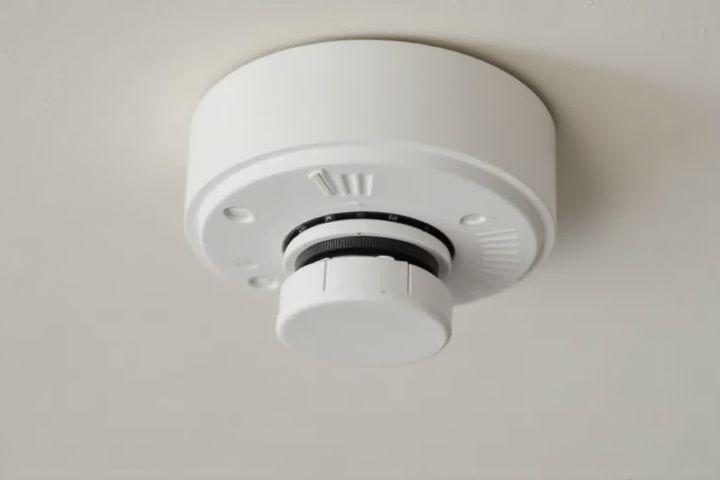
Install smoke detectors in every sleeping area, ensuring they are close enough to wake occupants in case of an emergency. Place detectors outside each separate sleeping area, such as hallways leading to bedrooms, to provide early warning. Mount smoke detectors on ceilings, as smoke rises, ideally 4 to 12 inches away from walls if placed on the wall. Maintain detectors on every level of your home, including basements and attics, to enhance overall safety. Regularly test your detectors and replace batteries at least once a year to ensure they are functioning properly.
Where To Install Smoke Detectors In A House
Inside each bedroom
Install smoke detectors inside each bedroom to enhance safety and ensure quick detection during a nighttime emergency. Position the devices on the ceiling or high on a wall, ideally within 12 inches of the ceiling to optimize smoke detection sensitivity. Ensure that all bedrooms have interconnected smoke alarms; when one sounds, all alarms will alert, improving your response time. Regularly test these smoke detectors monthly and replace the batteries at least once a year to maintain optimal function.
Outside each sleeping area
Install smoke detectors in the hallway outside each sleeping area to ensure early detection during nighttime emergencies. The recommended height for installation is on the ceiling or high on the wall, ideally 4 to 12 inches from the ceiling. If your home has multiple levels, place a smoke alarm on each floor, including basements and attics. Make sure to test each unit monthly and replace batteries at least once a year to maintain optimal functionality.
On each floor level
Install smoke detectors on every floor level of your house, including the basement and attic if they are used as living spaces. Position units in hallways near sleeping areas, keeping them at least 10 feet away from cooking appliances to minimize false alarms. For larger homes, consider additional detectors in bedrooms and common areas to enhance safety. Regularly test your smoke detectors monthly and replace batteries at least once a year to ensure optimal functionality.
Near staircases
Install smoke detectors near staircases, ideally within 10 feet of the top and bottom to effectively detect smoke rising from lower levels or basement areas. If your home features multiple floors, placing one on each level enhances overall safety. Consider positioning the detector on the wall, 6 to 12 inches below the ceiling for optimal performance, as smoke rises quickly. Regularly test these detectors and change batteries at least once a year to ensure they remain functional.
In the living room
Install smoke detectors in your living room on the ceiling or high on the wall, at least 10 feet away from cooking appliances to minimize false alarms. If your living room is an open space connected to other rooms, place the detector near the entry point of the adjacent areas. Ensure the device is located where it can be easily heard, particularly during night hours, considering that sound levels may increase by 3 decibels in a quiet environment. Regularly test the smoke detector monthly and replace the batteries at least once a year to maintain optimal functionality.
In the hallway
Install smoke detectors in the hallway outside sleeping areas, as this placement ensures they can alert you effectively during nighttime emergencies. For optimal coverage, position smoke detectors on the ceiling or high on the wall, maintaining a distance of at least 10 feet from kitchens to minimize nuisance alarms. If your home has multiple floors, ensure each level is equipped with a smoke detector in the hallway, totaling a minimum of two detectors for most residences. Regularly testing these devices and replacing batteries at least once a year is vital for maintaining your home's safety.
Away from kitchen appliances
Install smoke detectors in areas outside bedrooms and on every level of your home to ensure maximum safety, positioning them at least 10 feet away from kitchen appliances to avoid false alarms. Place detectors on the ceiling or high on walls, ideally within 4 to 12 inches from the ceiling for optimal functionality. If your home has a basement, install a smoke detector on the ceiling at the top of the stairs leading up to the living area. Regularly check and replace batteries to maintain effective operation, with most detectors requiring battery changes every 6 months.
At least 10 feet from cooking areas
Smoke detectors should be installed at least 10 feet away from cooking areas to prevent false alarms triggered by everyday cooking activities. Place detectors on every level of your home, including inside bedrooms and near stairways, to ensure adequate coverage. Ideally, mount smoke detectors on ceilings or high on walls, as smoke rises, and follow manufacturer guidelines for optimal placement. Regularly test your smoke detectors every month and replace the batteries at least once a year to maintain their effectiveness.
High on walls or ceilings
Install smoke detectors high on walls or ceilings, as smoke rises and will reach these positions first. For ceiling-mounted detectors, place them at least 4 inches away from any wall to ensure accurate detection. If you opt for wall-mounted units, position them 4 to 12 inches from the ceiling for optimal efficiency. In homes with sloped ceilings, install the detector within 3 feet of the peak, avoiding corners where smoke can linger.
Away from windows and doors
Install smoke detectors at least 10 feet away from windows and doors to minimize false alarms caused by drafts and outside elements. Position them on every level of your home, including the basement and outside each sleeping area, ensuring a quick alert during emergencies. Ceiling-mounted alarms should be placed at least 4 inches away from any wall, while wall-mounted units should be installed 4 to 12 inches below the ceiling. Regularly test your smoke detectors monthly and replace batteries at least once a year to ensure optimal functionality.
